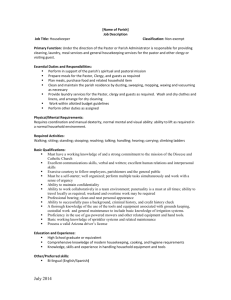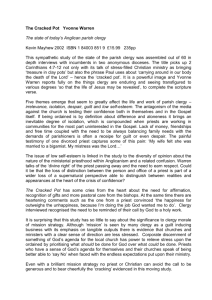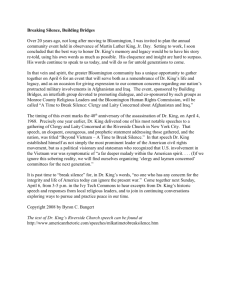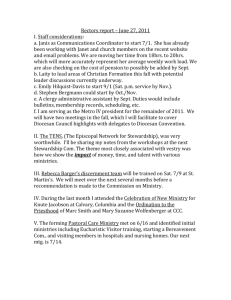Clergy Stress Essay
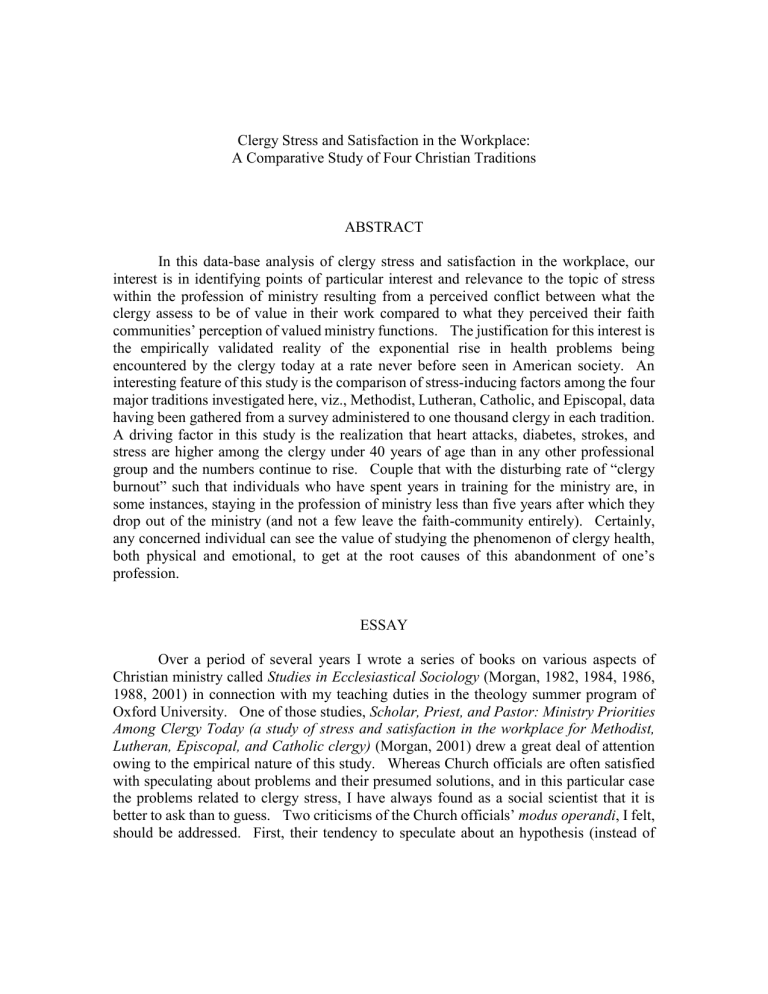
Clergy Stress and Satisfaction in the Workplace:
A Comparative Study of Four Christian Traditions
ABSTRACT
In this data-base analysis of clergy stress and satisfaction in the workplace, our interest is in identifying points of particular interest and relevance to the topic of stress within the profession of ministry resulting from a perceived conflict between what the clergy assess to be of value in their work compared to what they perceived their faith communities’ perception of valued ministry functions. The justification for this interest is the empirically validated reality of the exponential rise in health problems being encountered by the clergy today at a rate never before seen in American society. An interesting feature of this study is the comparison of stress-inducing factors among the four major traditions investigated here, viz., Methodist, Lutheran, Catholic, and Episcopal, data having been gathered from a survey administered to one thousand clergy in each tradition.
A driving factor in this study is the realization that heart attacks, diabetes, strokes, and stress are higher among the clergy under 40 years of age than in any other professional group and the numbers continue to rise. Couple that with the disturbing rate of “clergy burnout” such that individuals who have spent years in training for the ministry are, in some instances, staying in the profession of ministry less than five years after which they drop out of the ministry (and not a few leave the faith-community entirely). Certainly, any concerned individual can see the value of studying the phenomenon of clergy health, both physical and emotional, to get at the root causes of this abandonment of one’s profession.
ESSAY
Over a period of several years I wrote a series of books on various aspects of
Christian ministry called Studies in Ecclesiastical Sociology (Morgan, 1982, 1984, 1986,
1988, 2001) in connection with my teaching duties in the theology summer program of
Oxford University. One of those studies, Scholar, Priest, and Pastor: Ministry Priorities
Among Clergy Today (a study of stress and satisfaction in the workplace for Methodist,
Lutheran, Episcopal, and Catholic clergy) (Morgan, 2001) drew a great deal of attention owing to the empirical nature of this study. Whereas Church officials are often satisfied with speculating about problems and their presumed solutions, and in this particular case the problems related to clergy stress, I have always found as a social scientist that it is better to ask than to guess. Two criticisms of the Church officials’ modus operandi , I felt, should be addressed. First, their tendency to speculate about an hypothesis (instead of
collecting the data) and the presumption of truth (the false notion that what we “perceive” to be the truth “is” the truth) (Proeschold-Bell et. al. 2012a). When dealing with human reactions and emotions, it is not the truth one should seek but what the reacting person
“perceives” to be truth for it is on the basis of the perception that the individual reacts and not what is absolutely the truth. Social and behavioral scientists are never happy with either of these reductionistic tendencies, where the first one dismisses fact with prejudice and the second one presumes perception to be synonymous with the truth.
Since we will be looking at both stress and satisfaction, a brief comment about the definitional framework of these terms is important here (Morgan, 2012a). In our study, the use of the word stress was related to the “disparity” between the clergy person’s valuation assessment of duties and that of the faith community being served as perceived by the clergy person. Where there was a disparity between valuation of a particular duty or activity, we have labeled that “stress” and the situation a stress inducer. Where there is a conspicuous congruence of valuation assessment between the clergy person and his/her perception of the faith community, we have labeled that “satisfaction” and the situation a satisfaction inducer. According Lazarus, the pioneering researcher in stress back in the
1960s, “stress arises when individuals perceive that they cannot adequately cope with the demands being made on them or with threats to their well-being” (Lazarus, 1966). A decade later, Cox pointed out in his research that “stress can only be sensibly defined as a perceptual phenomenon arising from a comparison between the demand on the person and his or her ability to cope. An imbalance in this mechanism, when coping is important, gives rise to the experience of stress, and to the stress response” (Cox, 1978) Eventually,
Lazarus was joined by Folkman in the 1980s suggesting simply that “stress results from an imbalance between demands and resources” (Lazarus and Folkman, 1984). Finally and more recently, Palmer has suggested that “stress is the psychological, physiological and behavioral response by an individual when they perceive a lack of equilibrium between the demands placed upon them and their ability to meet those demands, which, over a period of time, leads to ill-health” (Palmer, 1989). As must be recognized, there is great need for more sustained and in-depth analysis of the particular health issues affecting the African
American clergy as indicated in two recent studies (Carter-Edwards, et. al. 2012; and
Stansbury and Schumacheer, 2008).
So, to get at what the clergy in these four traditions perceived to be truth about the situation and circumstances of ministry, I simply asked them a series of fact-finding questions, thereby sidestepping the dangers of speculation and avoiding the pitfalls of mistaking perception for truth. One thousand clergy in each of the four traditions, namely, Methodist(M), Lutheran(L), Catholic(C), and Episcopal(E), were asked to answer fifteen questions, carefully constructed according to the standard rules of research instrument design set forth by the social sciences. The data were collected, sorted, analyzed, and summarized in the book mentioned above. The driving motivation was to gather data based on clergy responses from which, then, conclusions about stress and satisfaction in the workplace could be reasonably drawn. Rather than having Church
official speculate about what they thought might be the character and cause of stress experienced by the clergy in the workplace, this study asked the clergy themselves to provide answers leading to a clearer understanding of the roots of stress as well as points of satisfaction in their actual ministry. Also, rather than ask members of the congregations what they thought and how they felt, the clergy themselves were asked what they thought and how they felt. On both counts, asking questions of the clergy and identifying their own perceptions of their situation, we believe this study came closer to actually understanding the nature of stress and satisfaction among the clergy far better than all of the speculative books by armchair Church officials could ever provide.
In this data-base analysis of clergy stress and satisfaction in the workplace, our interest is in identifying points of particular interest and relevance to the topic of stress within the profession of ministry resulting from a perceived conflict between what the clergy assess to be of value in their work compared to what they perceived their faith communities’ perception of valued ministry functions. The justification for this interest is the empirically validated reality of the exponential rise in health problems being encountered by the clergy today at a rate never before seen in American society
(Proeschold-Bell et. al. 2012b). Heart attacks, diabetes, strokes, and stress are higher among the clergy under 40 years of age than in any other professional group and the numbers continue to rise (Stewart-Sicking, 2012). Couple that with the disturbing rate of
“clergy burnout” such that individuals who have spent years in training for the ministry are, in some instances, staying in the profession of ministry less than five years after which they drop out of the ministry (and not a few leave the faith-community entirely). Certainly, any concerned individual can see the value of studying the phenomenon of clergy health, both physical and emotional, to get at the root causes of this abandonment of one’s profession.
Throughout and in deference to time and space, I will abbreviate references to
“average” numbers within the four traditions of Methodist, Lutheran, Catholic, and
Episcopal by using M, L, C, and E. Of the four thousand randomly selected clergy surveyed from a national data-base, one thousand in each of the four traditions, the average age was M=46, L=48, C=56, and E=53. Male gender was M=80%, L=98%, C=100%, and E=94%. Caucasian ethnicity was M=95%, L=96%, C=94%, and E=100%. Those holding “advanced degrees” beyond the credential required for ordination were M=32%,
L=38%, C=58%, and E=22%. It should be emphasized here that in a future study, both women and non-Caucasian clergy should be studied but in the data-base used for this study there were relatively meager numbers representing these two specific groupings of clergy.
Another variable which might prove relevant in the study of stress among clergy is that of rural parishes versus urban parishes. Naturally, there is much yet to be learned here.
In addition to the biographical data, the survey made inquiries regarding the actual clock-time spent discharging these fifteen specifically designated clergy functions during the average work week. Keep in mind that the actual “truth” is not being sought here, but rather what the clergy person “perceived” to be the truth about time allocations, for it is the
perception rather than the factual truth which determines the clergy person’s assessment of time spent discharging his/her duties. In the interest of efficiency, I will abbreviate the fifteen questions and beside each indicate the tradition and time reportedly spent on each.
Subsequently, we will report the “stress” and “satisfaction” assessments based on the disparity between what the clergy person perceived his/her “time valuation” to be versus what they perceived the parish’s “time valuation” to be. Here, most decidedly, is the basis for determines stress in the workplace, namely, the breadth of difference between what the clergy “thinks” is important versus what they perceive the parish to “think” is important.
ACTIVITIES of the clergy questioned and reported (hours reportedly spent)
1. Preparing the Sunday Homily
M=6.5 L=7 C=4.5 E=8.5
2. Studying/reading major theologians of the day.
M=2.25 L=2.5 C=2.5 E=2.5
3. Systematic, regular exegetical study of Scripture.
M=3.75 L=3 C=2.75 E=3.5
4. Serving as a spokesperson of authority for the teachings of the Church.
M=2.5 L=2.75 C=4 E=2.25
5. Functioning as a valued and respected intellectual within the life of the parish.
M=3.75 L=3.75 C=4.75 E=3.75
6. Leading the congregation in public worship.
M=3 L=3 C=8.25 E=2.5
7. Presiding over the Eucharist/Communion.
M=1 L=2 C=8.25 E=3.75
8. Exercising “sacramental” functions of ministry such as hearing confessions, baptizing, absolutions, anointing the sick., etc. (excluding Eucharistic celebrations).
M=3 L=2.5 C=4.5 C=3.25
9. Functioning as a spiritual Director to members of the parish.
M=4.5 L=3.75 C=3.25 E=2.75
10. Exercising discipline according to the canons of the Church including counseling as relates to discipline.
M=1.25 L=1.5 C=2.5 E=1.75
11. Involved in individual and family pastoral counseling sessions.
M=4 L=3.25 C=3.25 E=3.25
12. Involved in social activities within the life of the parish itself.
M=4.25 L=3 C=3.5 E=3.25
13. Involved in social activities within the life of the outside community.
M=3 L=2.75 C=2.5 E=2.75
14. Addressing within the public forum social, moral, and political issues of the day within the life of the community.
M=2 L=1.75 C=2.5 E=2
15. Serving the administration of the parish.
M=6.75 L=5.5 C=6.5 E=6.5
Note: What is interesting even before we commence a question-by-question analysis is the realization that among the Protestant clergy (M,L,E), 1. And 15., i.e., sermon preparation and church administration, constitute the primary time-allocations whereas with the Catholic clergy (C), 6. And 7., i.e., public worship and the celebration of the
Eucharist, consumed the greatest among of weekly time.
SUMMARY OF REPORTED WEEKLY HOURS SPENT DISCHARGING DUTIES
M=50 L=48 C=63 E=52
Of course, the tendency here, which must be avoided at one’s own peril, is to engage in a simplistic “comparison” of various traditions with an eye towards determining
“who is better,” “who works harder,” “what is really most important,” etc., etc., etc. This, certainly, will not do. What was the original purpose in this empirical study in the first place was to determine what the clergy in each tradition report to be how they spend their time “in relationship to” how they think the faith-community they serve wish them to spend their time. Here is the core of the stress-inducing phenomenon! When a clergy person thinks that his/her time is best spent doing “A” when he/she thinks that the parish both values “A” little but wishes the clergy person to be engaged in “B” which, in turn, the clergy person values less than “A,” here is the center of the storm creating stress (Wells, et. al. 2012). When what I wish to do (because it is how I define what it means for me to be a clergy person) comes into direct conflict with what I perceive my faith-community wishes me to be doing, therein lies the root cause of clergy stress. When both what the clergy wishes to do and the faith-community likewise wishes them to do are in sync, when they match, there is the core of “satisfaction” in the workplace for the clergy person. And, contrary to the many speculative works published by armchair Church officials, identifying these points of “stress” and “satisfaction” is not difficult! What might be difficult is to move the armchair officials off their speculations and onto the facts. Let us try to do it and see what happens.
Using 100% as the total possible response, the assessment of value attributed to each of the fifteen “activities” has been measured for both the clergy and the parish, remembering that the parish’s assessment of value is determined by the “clergy perception” of the parish’s assessment. In other words, if the clergy perceive their parish to wish them to spend more time studying Scripture, it really doesn’t matter what the “truth of the matter is” (if such could even be determined by a survey of the parish itself) (cf.
McCabe, et. al. 2007). What is important for stress-induction is the fact that the clergy person “perceives” the parish to have such a desire. So, the “clergy value assessment” of each of the fifteen activities is compared to the “parish value assessment” of each activity.
Where there is a 20% or more “variance” in the clergy assessment versus the parish
assessment, we have called that a “stress-inducer.” where there is less than 20% variance, we have called that a “satisfaction-inducer” (Wilson, et. al., 2007). (Again, the book goes into considerable detail regarding each of these “stress and satisfaction-inducing” activities but here we will simply summarize the findings.)
STRESS-INDUCERS (common to all and distinct to each tradition)
In the area of commonly experienced stress-inducing situations within all four traditions, there are three which stand out, namely, (1) the study of Scripture, (2) involvement in the social life of the parish, and (3) addressing social, moral, and political issues. All four denominations more or less generate stress over each of these three activities and in all three, without exception, it is the laity who lace a low ranking of importance on them, while the clergy, across the board, place a high mark of importance.
That stress is generated, and that conflict necessarily exists, is clearly borne out by the data.
Distinctive rather than common stress-inducing situations to each of the denominations has proven more interesting and telling. Among the Catholics, there is only one clearly distinct instance of a stress-creating situation, and that is over the issue of the pastor spending time studying contemporary theology. It should be mentioned here that the
Episcopal clergy share this particular experience (Stewart-Sicking, 2012). That the
Catholic laity think little of this enterprise, whereas priests think it quite important to engage in such study, calls for a concerted effort on the part of the clergy to inform and instruct the laity on the meaning and value of such study and its significance to the ongoing vitality of the priests’ ministry. A distinctive stress-inducer within the Lutheran tradition has to do with the pastor’s involvement in the social life of the outside community, an activity greatly devalued by the laity but much valued by the clergy. Again, more instruction of the parish on the meaning and value of this activity as it is a manifestation of the pastor’s role to evangelize and witness to the faith in the world is obviously required here, and, using a different tact, to challenge the parish to be less selfish with the pastor’s time and more giving and generous towards the community. This Lutheran tendency to see the pastor as “for the parish’ rather than “for the world” has been a consistent finding in this study.
Four stress-inducing situations we have found to be distinctively Methodist in character are, namely, (1) the pastor as intellectual, (2) presiding at Holy communion, (3) ecclesiastical discipline, and (4) administration. In every instance, the stress is created due to the laity’s low estimation of these particular forms of ministry and the pastor’s high valuation of their importance in the overall exercise of ministry. That the intellectual flavor of the clergy has not been a distinctive characteristic of the Methodist tradition is well established, but the pastor is today called upon more than ever to display an awareness of the affairs of the world and to demonstrate an acquaintance with the flow of public information. This trend and its importance must somehow be conveyed to the parish such that the laity become supportive of the pastor’s desire to participate in the intellectual activity of the community. Methodist clergy’s low showing as to holding advanced
degrees in theology and ministry (only the Episcopal clergy are lower) seems to be reflective of this tendency within the tradition to down-play scholarship generally.
The devaluation of the time spent in presiding at the Lord’s Table on the part of the
Methodist laity, while the clergy find themselves increasingly valuing this activity highly, might be suggestive of the still strong “Protestant” notion about the Eucharist among the laity and a growing sense of “catholicity” regarding Communion among the clergy.
Bringing Holy Communion into the central arena of the parish’s worship life within
Methodism is a recent development and has been initiated by the clergy rather than the laity. Whereas the sermon seems to be the focus of the congregation (72% rank it high), the Eucharist seems to be the increasing focus of the clergy (74% rank it high).
Another stress for Methodist clergy is the difference of opinion with respect to the meaning and nature of the exercise of ecclesiastical discipline, and this problem will not go away, since the core of the problem centers around the problematic of a balance between sola Scriptura and personal piety. These two emphases within the tradition preclude any strong sense of the meaningfulness and, indeed, rightfulness of discipline of any kind being administered by the clergy upon the laity. Finally, the matter of administration will be an enduring struggle between the laity (concerned with local parish life) and the clergy
(concerned with the management of the institutional church locally and nationally).
SATISFACTION-INDUCERS (common to all and distinct to each tradition)
This component of our study naturally proved the most pleasing for the identification of causes of satisfaction within the parish on the part of the clergy is, indeed, a worthy enterprise. And, we found five common satisfaction-inducers across denominational lines worthy of our attention. They are (1) sermon preparation, (2) serving as the Church’s spokesperson, (3) leading the public worship, (4) spiritual direction (with the exception of the Episcopalians), and (5) pastoral counseling. Clearly these are the areas among Protestants and Catholics, laity and clergy alike, where there will be mutual agreement, generally speaking, as to the high valuation allocated for ministry -- preaching, witnessing, worshipping, and spiritual and pastoral guidance. That pastors do themselves and their parishes a great service directly in proportion to the amount of time allocated for these five primary functions goes without saying. We would suggest that in most cases where stress is being generated in the parish setting, the pastor and the congregation would be well served if these five activities were to be accentuated.
The distinctive satisfaction-inducers, those unique to each individual tradition, were less clear among the Protestants, none showing up in the data for the Methodist tradition and only one for the Lutherans. When we remember that seven out of fifteen activities were stress-inducing for Methodist clergy, whereas for Lutherans and
Episcopalians only four and for Catholics only three, we should have anticipated that satisfying situations would be less likely distinctive to the Methodist tradition than to the other three. For Lutherans and Episcopalians, the highest single activity of satisfaction
not held in common with the other two traditions was that of presiding at the Eucharist
(which they shared with Catholics but not Methodists). This reflects a growing sense of
“catholicity” among the Lutheran and Episcopal Church leaders and laity in America and the trend will certainly continue. Distinctive satisfaction-inducing situations for the
Catholics number three and they include (1) presiding at the Eucharist (shared with
Lutherans but not Methodists), (2) sacramental ministries other than Eucharist, and (3) involvement in the social life of the parish. These three activities are historically characteristic of Catholic clergy and today the level of satisfaction between clergy and laity in these three areas proves to be a distinctive mark of the relationship which exists between the priest and the parish in the Catholic Church. It is a source of strength and hope for their future as well (Boehnlein, 2006).
It would be unfair of us, on the basis of this one study, to attempt to pontificate as to the full scope of ministry in today’s Church or to propose that we have both identified the causes of stress among the clergy and a solution to that problem. We have, however, studied four thousand randomly selected clergy divided equally among four major
Christian traditions. That which has caught and sustained our attention throughout this study has been those activities of ministry which are perceived by the clergy themselves to be stress inducing and, happily, those likewise which are satisfaction-inducing activities.
We have attempted to highly problem areas in order both to deepen our understanding of the problems and to hopefully provide relevant information for those in decision-making positions of power and leadership upon which to act.
Several major problems across the board have presented themselves to us, such as the need for communities of faith to be better informed and educated as to the nature and function of ministry and the relevance of such activities as studying Scripture and theology, and, in many instances, the need for the community to be appreciate the relevance of clergy activity in the wider world beyond the parish. But one of the most striking and consistently troubling phenomena gleaned from this study has been the quite obvious reality of the overworked clergy. That is to say, clergy are quite obviously spending too many hours on the job discharging too many duties with too many stresses and frustrations, many brought on by their own perceptions of parish expectations and in others by their own self-understanding as to the nature of ministry. Whatever the cause, clergy stress and exhaustion -- physical, emotional, spiritual -- is a problem that will not go away easily and must be addressed by both the lay and clerical communities alike.
Whether suffering from a messiah complex (I must save the world) or from an anxiety about job security (I must keep proving myself), the problem is real and pervasive
(Williams, et. al., 2004)..
Throughout this study, we have endeavored to make clear the fact that what is being discovered in these data are “clergy perceptions” rather than either perceptions of and by the laity or insights gained by an objective gleaning of parish-based responses. The issue before us from the outset has been “clergy perceptions” of these various ministry activities such their perceptions determine their outlook on their communities and their ministries
(Ali, et. al. 2005; Morgan, 2010).
Other studies might be done in which the parish itself is asked to address the same and similar questions regarding their won understanding of ministry and their expectations regarding their clergy. It would be, indeed, a worthwhile endeavor. Yet, nevertheless, it would be quite different from what we set out to do and the findings may or may not corroborate ours here. But in closing, let us be clear in what we have done. We have asked the clergy to tell us what they do with their time and how they evaluate those activities in terms of priorities, and, secondly, we have asked them to share with us what they think their communities of faith think and feel about those same activities in terms of priorities. In so doing, we have identified points of stress and points of satisfaction felt by the clergy in the exercise of their ministry. If we have done this, we have fulfilled our goal. If not, it still needs to be done.
END NOTES
Ali, O. M., G. Milstein, and P. M. Marzuk. “The Imam's Role in Meeting the Counseling
Needs of Muslim Communities in the United States.” Psychiatric Services. February,
56(2):202-5.
Boehnlein, J. K. (2006). “Religion and spirituality in psychiatric care: looking back, looking ahead.” Transcultural Psychiatry. December, 43(4):634-51.
Carter-Edwards L, E. G. Hooten, M. A. Bruce, F. Toms, C. L. Lloyd, and C. Ellison
(2012). “Pilgrimage to Wellness: an Exploratory Report of Rural African American
Clergy Perceptions of Church Health Promotion Capacity.” Journal of Preventive
Intervening Community. 40(3):194-207.
Cox, T. (1978). Stress . Basingstoke: Macmillan Education.
Gallo, L. C., and K. A. Matthews (2003). “Understanding the Association Between
Socioeconomic Status and Physical Health: Do Negative Emotions Play a Role?”
Psychological
Bulletin 129 (January): 10-51.
Hawkley, L. C., and J. T. Cacioppo (2003). “Loneliness and Pathways to Disease.”
Brain,
Behavior, and Immunity 17, Supplement 1 (February): S98-S105.
Lazarus, R. S. (1966). Psychological stress and the coping process . New York: McGraw-Hill.
Palmer, S. (1989). “Occupational stress.”
The Health and Safety Practitioner , 7, (8), 16-18.
McCabe, O. L., J. M. Lating, G. S. Everly, Jr., A. M. Mosley, P. J. Teague, J. M. Links, and
M. J. Kaminski (2007). “Psychological first aid training for the faith community: a model
curriculum.“ International Journal of Emergency Mental Health Summer, 9(3):181-91.
Morgan, John H. (1982). WOMEN PRIESTS: A National Reality (Bristol, IN: Wyndham Hall
Press).
Morgan, John H. (1984). WIVES OF PRIESTS: a National Study (co-authored with Linda Morgan)
(Bristol, IN: Wyndham Hall Press).
Morgan, John H. (1986). WHO BECOMES BISHOP?: a Study of Career Advancement (Bristol,
IN: Wyndham Hall Press).
Morgan, John H. (1988). THE DIACONATE TODAY: The New Search for an Old Ministry
(Bristol, IN: Wyndham Hall Press).
Morgan, John H. (2001). SCHOLAR, PREIST, AND PASTOR: Ministry Priorities Among the
Clergy Today (A Data-Base Study of Stress in the Work Place) (Lima, OH: Wyndham Hall Press).
Morgan, John H. (2010). MUSLIM CLERGY IN AMERICA: Ministry as Profession in the
Islamic Community . (The Victoria Press, 2 nd
Expanded Edition).
Morgan, John H. (2012a). CLINICAL PASTORAL PSYCHOTHERAPY: A Practitioner’s
Handbook for Ministry Professionals.
Expanded 2 nd
Edition (Mishawaka, IN: GTF Books).
Morgan, John H. (2012b). BEGINNING WITH FREUD: The Classical Schools of
Psychotherapy 2
ND
Edition (Lima, OH: Wyndham Hall Press).
Proeschold-Bell, R.J., S. LeGrand, A. Wallace, J. James, H. E. Moore, R. Swift, and D.
Toole (2012a). ‘Tailoring health programming to clergy: findings from a study of United
Methodist clergy in North Carolina .
”
Journal of Preventive Intervening Community.
40(3):246-61.
Proeschold-Bell, R. J. and P. J. McDevitt. (2012b). “An Overview of the History and
Current Status of Clergy Health.” Journal of Preventive Intervening Community
40(3):177-9.
Stansbury, K. and M. J. Schumacher (2008). “An exploration of mental health literacy among African American clergy.” Journal of Gerontological Social Work .
51(1-2):126-42.
Steward-Sicking, J.A. (2012). “Subjective well-being among Episcopal priests: predictors and comparisons to non-clinical norms.” Journal of Preventive Intervening
Community. 40(3):180-93.
Surwit, R. S., M. A. van Tilburg, N. Zucker, et al. (2002). “Stress Management Improves
Long-Term Glycemic control in Type 2 Diabetes.” Diabetes Care 25 (January): 30-34.
Wells, C. R., J. Probst, R. McKeown, S. Mitchem, and H. J. Whiejong (2012). “The
Relationship Between Work-Related Stress and boundary-Related Stress Within the
Clerical Profession. Journal of Religon and Health . March, 51(1):215-30.
Williams, M. L., M. Wright , M. Cobb, and C. Shiels. (2004). “A Prospective Study of the
Roles, Responsibilities and Stresses of Chaplains Working Within a Hospice.” Palliative
Medicine. October, 18(7):638-45.
Wilson, R. S., S. E. Arnold, J. A. Schneider, Y. Li, and D. A. Bennet (2007). “Chronic distress, age-related neuropathology, and late-life dementia.” Psychosomatic Medicine
Jan, 69(1):47-53.

